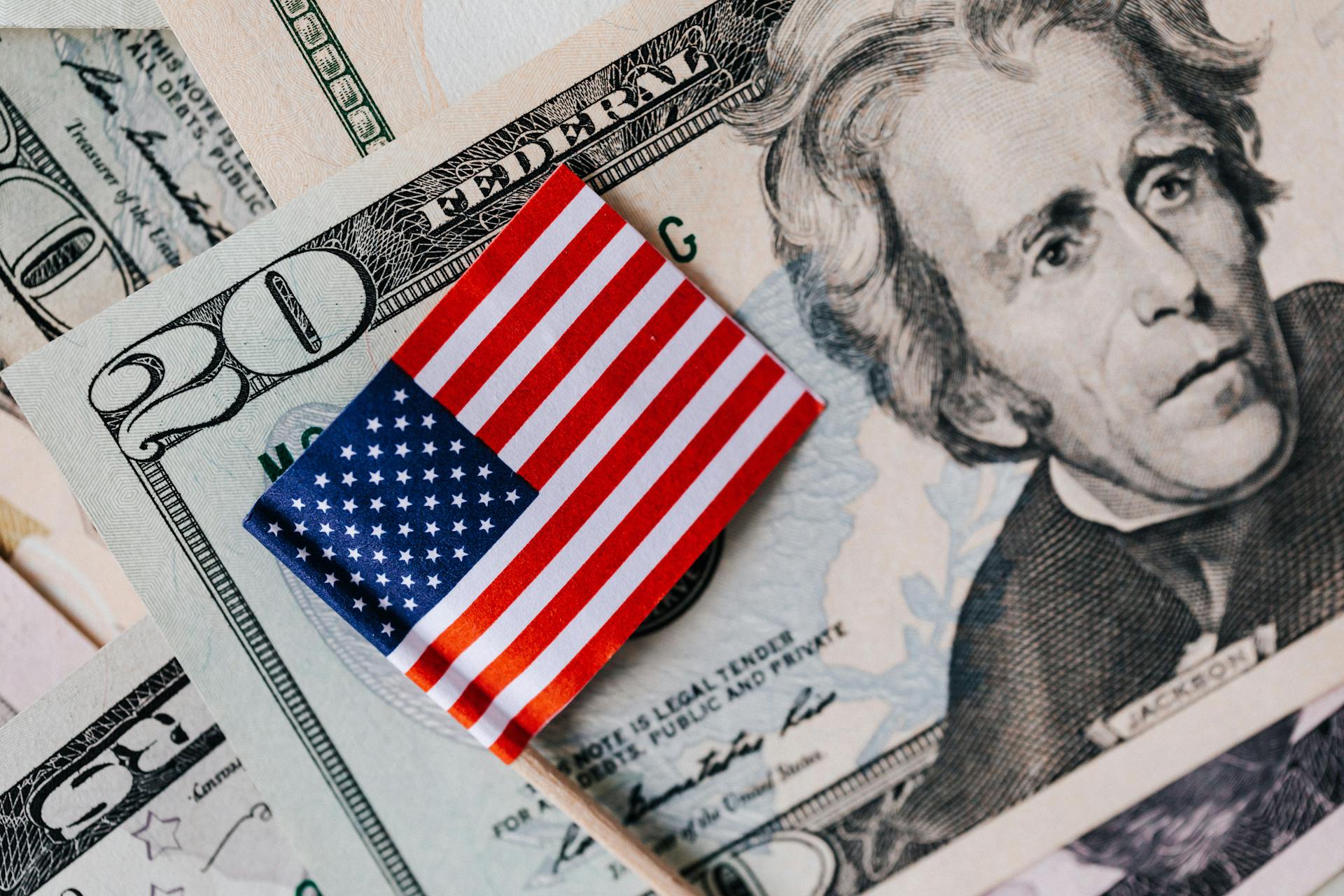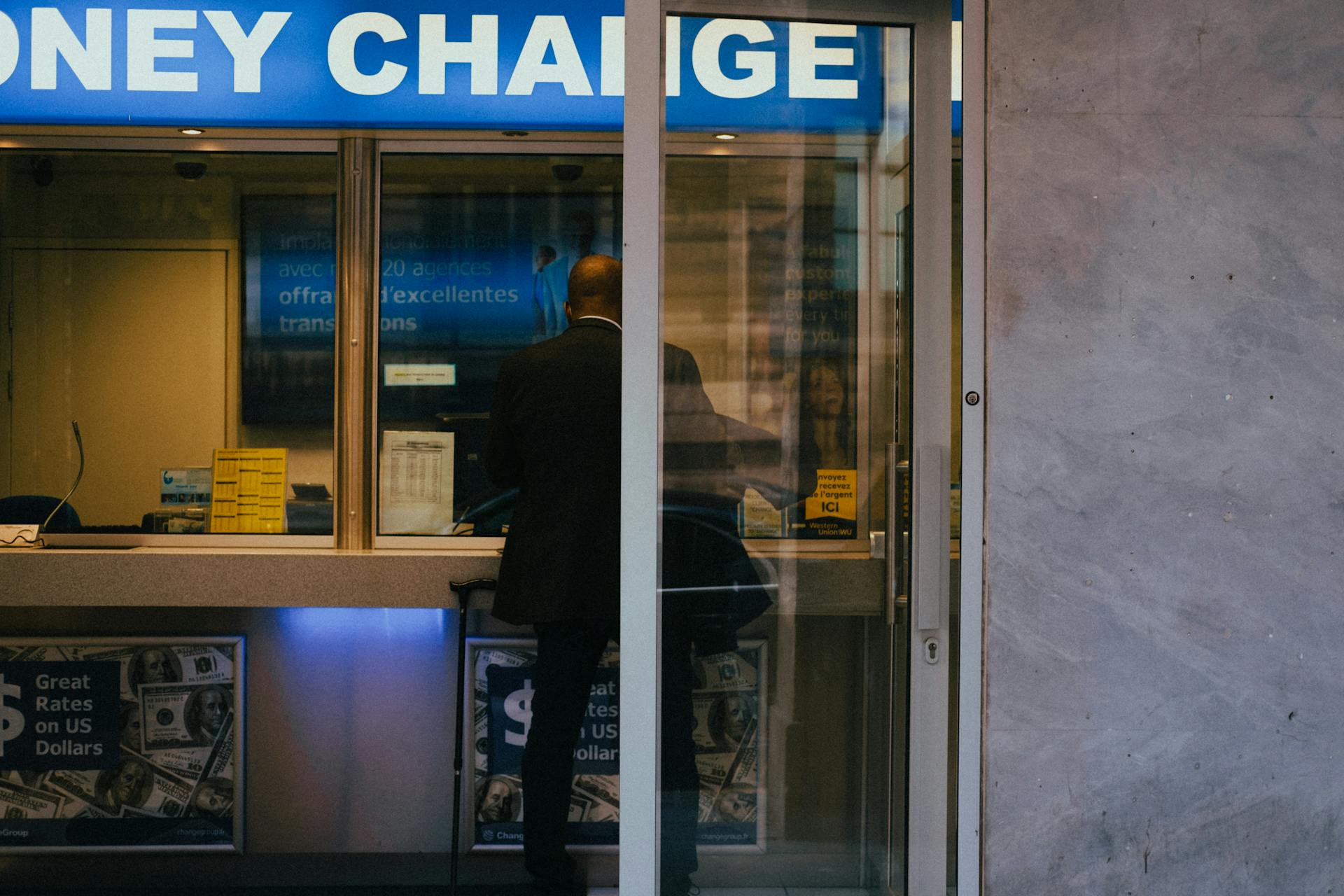
Saudi Arabia's Petro Dollar has been a cornerstone of US power for decades. The US dollar's value has been artificially inflated due to the petrodollar's dominance, making it a preferred currency for international trade.
This has given the US a significant advantage in global economic affairs. The petrodollar's influence has also allowed the US to maintain a strong military presence around the world.
The petrodollar's grip on the global economy is slowly starting to loosen. The rise of alternative currencies and the increasing use of digital payments are eroding the petrodollar's dominance.
The US is facing increasing competition from other nations, particularly China, which is rapidly becoming a major player in the global economy.
Here's an interesting read: Petrodollar June 9
The Petrodollar System
The Petrodollar system has been a cornerstone of the global economy since the 1970s, with most international oil transactions conducted in US dollars.
The system was formed after the collapse of the Bretton Woods system in 1971, which ended the US dollar's convertibility to gold. The US formed strategic agreements with Saudi Arabia and other OPEC countries to stabilize the dollar and maintain its global dominance.
As of 2023, approximately 80% of the world's oil transactions are priced in US dollars. Petrodollars are the dollars earned by countries through the sale of oil and other petroleum products.
The Petrodollar system has significantly benefited the US economy, helping maintain the dollar's value and status as the world's primary reserve currency. The system has also given the US a degree of leverage over oil-exporting countries, which rely on the stability of the US dollar.
Here are the key takeaways about the Petrodollar system:
- Petrodollars are dollars paid to oil-producing countries for their exports.
- The petrodollar emerged as an economic concept in the 1970s as growing US imports of increasingly costly crude oil increased the dollar holdings of foreign producers.
- Petrodollar recycling is the reinvestment of crude oil export revenue denominated in dollars.
- The dollar's status as the leading global currency preceded petrodollar's rise and has continued amid increased US energy production and widening current account deficits.
Challenges to the Petrodollar
The petrodollar system has been a cornerstone of the global economy for decades, but it's facing increasing challenges. The rise of alternative currencies, such as the yuan, is making it more difficult for the dollar to maintain its dominance.
Saudi Arabia, a key player in the petrodollar system, is exploring ways to diversify its currency reserves. In 2023, Saudi Finance Minister Mohammed al-Jadaan stated that the kingdom is open to settling trades in non-dollar currencies.
The use of alternative currencies is not limited to Saudi Arabia. Russia, for example, has switched from the dollar to the yuan for much of its commodities trade with China. Iran has also done the same due to US sanctions.
The petrodollar system relies on oil-exporting countries holding US dollars to buy oil, creating a consistent demand for the currency. However, the increasing use of alternative currencies is reducing this demand.
The dollar's dominance is also being challenged by the BRICS nations, which include Saudi Arabia, Iran, Ethiopia, Egypt, Argentina, and the United Arab Emirates. These countries are working together to create a more multipolar world and reduce their dependence on the dollar.
Here are some key statistics on the challenges to the petrodollar:
The challenges to the petrodollar system are not limited to the use of alternative currencies. The US dollar's value is also being affected by the country's growing protectionism, political dysfunction, and overuse of sanctions.
US-Saudi Relations
US-Saudi Relations have been strong for decades, with the two countries cooperating on various fronts, including energy and security.
The US has been a long-time ally of Saudi Arabia, providing military support and training to the kingdom's armed forces since the 1950s.
In 1945, the US and Saudi Arabia signed the Treaty of Friendship, Treaty of the Desert, and Economic Agreement, which marked the beginning of their diplomatic relations.
The US has also provided significant economic support to Saudi Arabia, with the two countries signing a series of defense and security agreements, including the 1951 US-Saudi Arms Deal.
This close relationship has allowed Saudi Arabia to maintain its position as a major oil producer, with the US serving as a key market for its oil exports.
The US and Saudi Arabia have also collaborated on regional security issues, with the US providing military support to the kingdom during the Gulf War in 1991.
A different take: Countries That Use American Dollars
Saudi-US Relations
Saudi-US Relations have been a cornerstone of international diplomacy for decades, with the two countries cooperating on various fronts.
The 1945 Atlantic Charter marked the beginning of this relationship, as the US and the UK issued a joint statement outlining their post-war goals, which included the principle of self-determination for all peoples.
In 1945, President Franklin D. Roosevelt met with King Abdulaziz in the first-ever meeting between a US President and a Saudi monarch.
The two countries have maintained a strong alliance, with the US providing military aid to Saudi Arabia during the Gulf War in 1990-1991.
Saudi Arabia has also been a key player in the US's Middle East policy, hosting US military personnel and equipment at key bases.
The 2011 US-Saudi Strategic Partnership Framework solidified their relationship, outlining areas of cooperation in defense, energy, and counter-terrorism.
The US has also provided significant economic support to Saudi Arabia, with the US being one of the country's largest trading partners.
Curious to learn more? Check out: Countries That Have Dollarized
Security
Saudi Arabia's security concerns have multiplied due to new conflicts in the region.
The country's 2015 military intervention in Yemen involved considerable military expenditure, as it supported the Yemeni government against Houthi rebels.
Higher defense spending and strategic repositioning were needed to address the growing threat of terrorism and regional instability.
The rise of the Islamic State, which seized control over significant swaths of territory in Iraq and Syria, added to Saudi Arabia's security woes.
To counter these threats, Saudi Arabia has had to adapt its security strategies, including increased military spending.
A Murky Future
A Murky Future for the Petrodollar?
The US ability to impose extraterritorial sanctions on trade that doesn't affect them is a major reason for oil exporting states to diversify beyond the dollar. This has become a propensity under the US, where the dollar was weaponized to block trade between Europe and Iran, Venezuela, and Cuba.
The US was able to undermine these trade initiatives due to the prevailing dependence on the dollar and the US banking system in global commerce. This essentially forced foreign firms to forgo access to the US market if they chose to do business with sanctioned entities.
Oil's de-dollarization has already started with Russia and Iran switching from the dollar to the yuan due to US sanctions. This is a clear indication that the petrodollar's grip on the global economy is weakening.
Even the US-allied blocs, such as the European Union, are now considering switching currencies when trading with strategic competitors of the US, like China. This is because they face the prospect of US-imposed extraterritorial sanctions on their trade.
The hazards of US sanctions have already pushed Russia away from the dollar, and now China is shifting in the same direction. This trend is likely to continue, as more countries realize the risks of relying on the US-dominated financial system.
Conclusion
The analysis of the petrodollar system reveals a more complex reality than initially meets the eye.
The US government was extremely active throughout 1974 on the petrodollar front, shaping the international monetary and financial system.
The acceptance of the petrodollar system by other actors does not imply its "naturality", but rather the result of US actions and diplomatic démarches.
The Saudi role as a large investor of petrodollars in the US is still not fully understood, but it's likely that US actions had a significant weight on Riyadh's decisions.
US offers of military "protection" to Saudi Arabia may have played a role in shaping their choices.
The transformation of US power in the 1970s, to the extent it depended on petrodollars, should not be considered the result of mere "fortune", but rather the active deployment of US power itself.
The renewal and transformation of US power was formalized in April 1978 with the second amendment to the IMF's charter, marking the beginning of a pure dollar standard.
On a similar theme: Saudi Arabia Not Renewing Petrodollar Agreement
Frequently Asked Questions
Is Saudi Arabia decided not to sell oil in US dollar anymore?
No, Saudi Arabia has not stopped selling oil in US dollars. In fact, they have expanded their sales to include various currencies, including the US dollar.
What is the dollar contract with Saudi Arabia?
The dollar contract with Saudi Arabia is a commitment to use dollar revenues from oil sales to buy US Treasuries. This agreement underpins the global petrodollar system, linking oil trade to US debt financing.
What happens if oil is not traded in dollars?
If oil is not traded in dollars, it could weaken demand for the U.S. dollar and potentially undermine its status as the global reserve currency. This shift could have significant implications for the global economy and the value of the dollar.
Sources
- https://www.energyhistory.eu/en/special-issue/oil-dollars-and-us-power-1970s-re-viewing-connections
- https://arabcenterdc.org/resource/exploring-the-options-arab-oil-exporters-and-the-us-dollar/
- https://www.investopedia.com/articles/forex/072915/how-petrodollars-affect-us-dollar.asp
- https://www.project-syndicate.org/onpoint/saudi-petrodollars-do-they-matter-for-us-currency-hegemony-by-carla-norrlof-2024-07
- https://fpif.org/from-petrodollar-to-mineralyuan/
Featured Images: pexels.com


